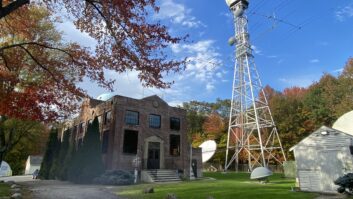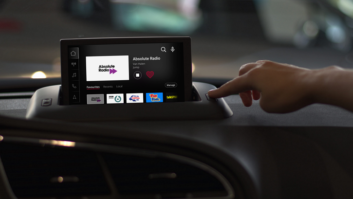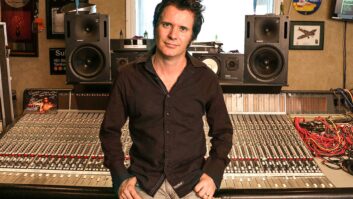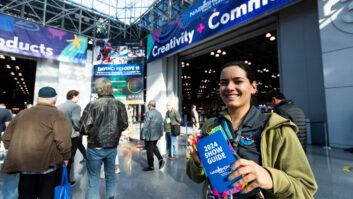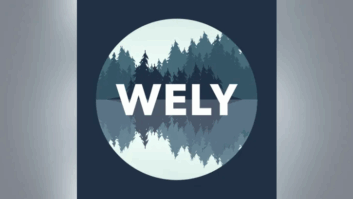
Jacob Javits Convention Center
Credit: Courtesy Jacob K. Javits Center
East Coast broadcasters and audio professionals, take note: The AES is making its biennial visit back to New York in October.
The 135th Audio Engineering Society Convention, Oct. 17–20, marks a return to the Jacob K. Javits Center in New York City. It’s a gathering for audio pros in all disciplines — motion picture production, music recording, live sound, audio research and engineering — in one of America’s great cities. And there will be plenty for radio broadcasters to get interested and excited about.
Familiar and notable figures from the radio industry will address concerns relevant to the modern broadcaster, including disaster preparation, the future of remote broadcasting and the unexpected and perhaps unsettling question, “Is the MP3 obsolete?”
And of course, there’s that convention hall full of all the cool new equipment.
NEW PRODUCTS
The roster of manufacturers and exhibitors will no doubt change between now and the show, but an early peek reveals some amazing new products.
Izotope first hit the streets more than a decade ago, with a free vinyl simulator. This year, the company is rolling out RX 3 Advanced, described by Jay LeBoeuf, strategic technical director of Izotope, as a “Complete Audio Repair” kit.
“The DeReverb module reduces room echo,” he told RW, “and it works as a plug-in or as a standalone audio editor. You can do all your cleanup right inside the program.” LeBoeuf says the product is suitable for audio engineers, podcasters and broadcasters.
Tascam cassette and DAT decks have been inside radio studios for years. This fall, the company is helping get people out of the studio, with the debut of the DR60D, a solid-state four-track linear field recorder, primarily meant to pair with a DSLR video camera. But with an internal mixer, limiter and phantom power, the DR60D can well be used for radio press conference recording and roundtable discussions with up to four microphones.
No one can deny the versatility of using smartphone devices as audio recorders. Tascam addressed that as well with the debut of the iM2X stereo mic for the iPhone 4S. According to Marketing Manager Garyn Jones, “It uses the same high-quality condenser mics as on our DR-40 recorder, and it has its own A/D converter, bypassing the mic electronics of the iPhone.”
Eventide, maker of the legendary Harmonizer line, is preparing for the release of the H9 “stomp box” processor. While rackmount gear is more familiar to radio production people, the H9 packs the punch of five other Eventide processors into one box, and can be controlled remotely via MIDI or iOS Bluetooth. And of course, it features the big Eventide Knob we all like to spin.
For broadcasters, much of the equipment on display is too studio-oriented — but not all of it. Microphones will be well-represented by Audio-Technica, AEA, Cloud, Earthworks, MXL and Neumann, among others; and radio favorite Sound Ideas is on the list, bringing in its huge collection of sound effects and the Mix Music Library.
SESSIONS
Workshops, panel presentations and white papers are for when it’s time to step back from the toys and actually get some work done. This year, many scheduled sessions are well worth your attention, some with familiar hosts.
The disaster known as Superstorm Sandy left behind a lot of damaged property and, as many readers will attest, a lot of stations were knocked off the air in New York and New Jersey. If that happened where you were located, would you know how to stay on the air and survive the ordeal? If not, you need to be in session B7: “Broadcasting During a Disaster,” Friday, Oct. 18, 12:30–2 p.m.
This session will be chaired by Glynn Walden, senior vice president of engineering for CBS Radio. He’ll be joined by Thomas R. Ray III, now president of Tom Ray Broadcast Consulting, who can provide commentary and describe his own experiences with Sandy. He was director of engineering for Buckley Broadcasting in New York at the time Sandy struck, and recounted his adventures in the article “Riding Out Hurricane Sandy,” Radio World, Dec. 5, 2012.
“Stations in New Jersey were underwater,” he told Radio World. “At WOR(AM), we were off the air because we had no phones, no Internet, no cable TV.”
The best way to stay on the air is to anticipate what can go wrong, with experience as one’s guide.
“Take a look and see what your vulnerabilities are. You have to think things through, and fast,” Ray said. “You have to determine the best and fastest method to get back on the air.
“For personnel at the transmitter site, you need to have food, water and a cot or a sleeping bag. You need more than one day of fuel for the generator. And if you don’t have a generator, maybe it’s time to get one.”
Walden and Ray will be joined by Rob Bertrand of CBS, Howard Price of ABC/Disney and Richard Ross from WADO/Univision.
Big names from big companies like Orban, NPR, Fraunhofer and CBS New York are coming together to discuss the question, “Is it Time to Retire the MP3 Protocol for Streaming?” — a late afternoon session on Thursday, Oct. 17, starting at 5:30 pm. Among presenters is Greg Shay, chief science officer of the Telos Alliance.
“I don’t think it’s time that it goes away,” Shay stressed, “but there are additional possibilities opening up. When ISDN was the only thing we had, then [MP3] was the only thing you could do. Higher speed networks are becoming available, and you have more options.”
Numerous factors are at play today, prime among them the cost of hardware vs. cost of bandwidth, and listener expectation as to what is acceptable audio. “Network bandwidth is not a limiting factor anymore,” he said. “You can do things all the way out to linear.”
Up-to-date listings of exhibitors and presenters can be found at the Audio Engineering Society web page www.aes.org along with registration details.
Alan Peterson is a longtime RW writer, 35-year broadcast pro, SBE-certified audio engineer and enthusiastic convention-goer whenever the AES is in New York.
